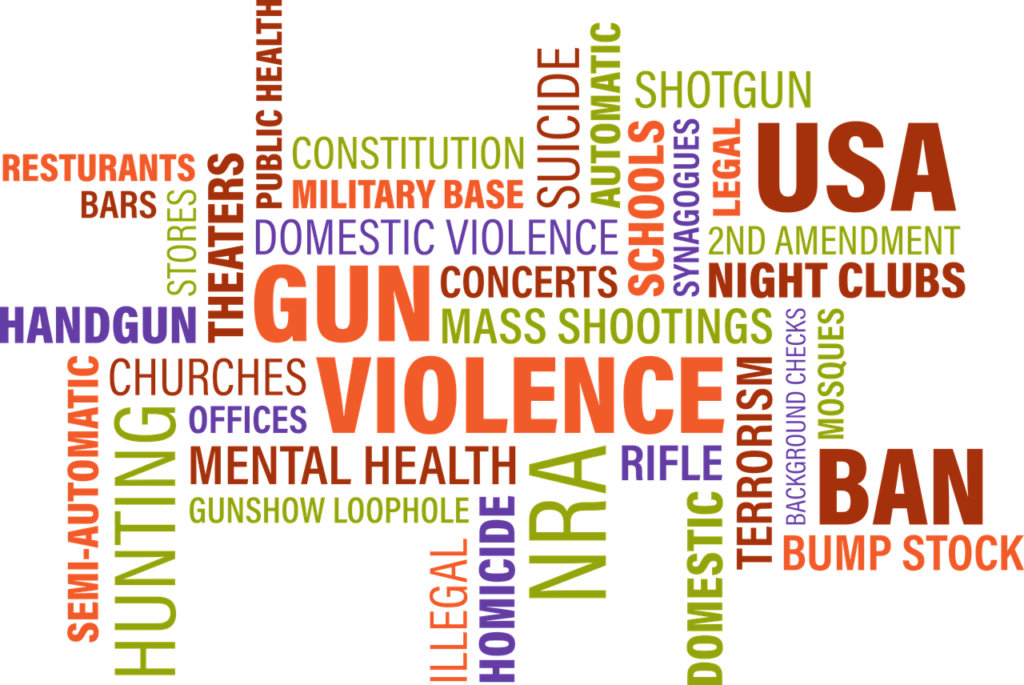
In this second article of the series, we’ll dive into research and analysis in order to better understand all the factors or causes that contribute to gun violence and mass shootings. We’ll proceed by addressing a series of questions that enable us to better understand the multi-faceted nature of gun violence, both in terms of problems and solutions. But first, we need to lay the foundation for the discussion by addressing the 2nd Amendment and how America compares with the rest of the world in terms of access to guns and gun violence.
American and World Views Regarding Guns
Currently, America is one of only three countries in the world—Mexico, Guatemala, and the United States—to enshrine the right to bear arms in its constitution. The 2nd Amendment to our Constitution reads:
“A well regulated militia, being necessary to the security of a free state, the right of the people to keep and bear arms, shall not be infringed.”
The U.S. Supreme Court has interpreted the scope of the 2nd Amendment on many occasions; but the 2008 case of District of Columbia v. Heller is widely regarded as a landmark ruling. The decision clearly protects an individual’s right to own guns, including the right to keep handguns in the home for purposes of self-defense. However, 2nd Amendment rights are not unlimited. Said Justice Antonin Scalia, who wrote the majority opinion:
“Like most rights, the right secured by the Second Amendment is not unlimited. [It is] not a right to keep and carry any weapon whatsoever in any manner whatsoever and for whatever purpose.”
Justice Antonin Scalia
The Heller decision also includes commentary laying a threshold or guidelines for the regulation of firearms, saying that the government cannot prohibit guns “in common use” at the time; but that it could prohibit the carrying of “dangerous and unusual weapons.”
Given the specific constitutional protection and the history of Supreme Court rulings that largely protect this right, let’s turn our attention to how America compares with the rest of the world in terms of guns and gun violence. There is no official data on the total number of guns in America because the federal government doesn’t track such figures. However, there are numerous surveys and other sources of information that lead to the conclusion that the US has far higher rates of gun ownership than any other country. Here is some of the evidence:
As of 2018, there were an estimated 393 million civilian-owned firearms in the U.S., according to the Switzerland-based Small Arms Survey, a government-backed global organization. This is more guns than there are people, over 120 guns per 100 residents.
Here is the breakout of the 10-largest gun owning countries:

It’s possible that these eye-popping numbers may be understated. Another organization that tracks firearms in the US, the National Shooting Sports Foundation (NSSF), reports that as of 2020, American civilians possess over 434 million firearms.
Turning to statistics on gun violence, CNN has recently reported that the US has the highest firearm homicide rate in the developed world. The report cites the following statistics and findings:
- In 2019, the number of US deaths from gun violence was about 4 per 100,000 people. That’s 18 times the average rate in other developed countries.
- Multiple studies show access to guns contributes to higher firearm-related homicide rates.
- The US was home to 4% of the world’s population but accounted for 44% of global suicides by firearm in 2019.
- No other developed nation has mass shootings at the same scale or frequency as the US.
Additional statistics documenting America’s gun violence—including deaths, suicides, injuries, and mass shootings—can be found online at the Gun Violence Archive. Since it started reporting data in 2014, the numbers are clearly trending up, with over 48,000 fatalities in 2022 alone. In recent years, there have been 610 to 690 mass shootings each year.
Is Gun Violence a Result of Ease of Access to Firearms?
Clearly, Americans have extremely high levels of access to guns and gun ownership; and clearly, America has extremely high levels of gun violence, including suicides, mass shootings, and other criminal activity, and accidents. Is it thus valid to conclude that these two phenomena are directly related, so that solving the problem of gun violence is simply a matter of reducing the number of people owning guns and reducing the total number of guns? Unfortunately, no.
First, let’s look at trends in gun ownership, both as to individuals who personally own a gun and guns within households. Here’s what Gallup reports as to US adults:

As we can see, in 2020, 44% of Americans live in a household with a gun, while 32% of American adults personally own a gun. And, we can also see that the percentages have been fairly consistent over time. Given that the adult population of the United States was 253.8 million in 2020, this means that about 81.2 million adults in the US personally owned a gun in 2020. Of this number of gun owners, is there any way to tell how many commit acts of gun violence during their lifetime?
The short answer is that we don’t know, as there is no established database that tracks gun owners who commit acts of gun violence. We can look at some statistics, however, that lead to the conclusion that the vast majority of Americans owning guns are law abiding. When we compare the huge number of gun owners (81 million) with the much smaller number of suicides, mass shootings, deaths, and injuries (40,000 to 50,000 per year), it’s fairly obvious that most gun owners were not involved in gun violence in any given year.
Another way to validate whether the vast majority of American gun owners are law-abiding, is to look at who is committing gun violence and how they are getting their guns. Let’s look at this evidence.
A recent study on mass shootings from the National Institute of Justice reveals the following:
- “Suicidality was found to be a strong predictor of perpetration of mass shootings. Of all mass shooters in the database, 30% were suicidal prior to the shooting, and an additional 39% were suicidal during the shooting.”
- “In terms of past trauma, 31% of persons who perpetrated mass shootings were found to have experiences of severe childhood trauma, and over 80% were in crisis.”
- “Except for young school shooters who stole the guns from family members, most used legally obtained handguns in those shootings.”
- “Nearly half of individuals who engaged in mass shootings (48%) leaked their plans in advance to others, including family members, friends, and colleagues, as well as strangers and law enforcement officers.”
- “Of the individuals who engaged in public mass shootings covered in the database, 97.7% were male. Most individuals who perpetrated mass shootings had a prior criminal record (64.5%) and a history of violence (62.8%), including domestic violence (27.9%). And 28.5% had a military background.”
A 1998 JAMA study found that legally authorized handgun purchasers with prior misdemeanor convictions are at increased risk for future criminal activity, including violent and firearm-related crimes.
A 2016 survey of prison inmates by the Bureau of Justice Statistics found that 43% of guns used in crimes were obtained from the black market, 25% from an individual, 10% from a retail source (including 0.8% from a gun show), and 6% from theft.
In summary, most of the gun violence in America either appears to be coming from individuals in crisis (some of whom may be suicidal), or from individuals who engage in gun violence as a part of criminal activity. Also, most of the guns used in criminal activity come from the black market, an individual, or theft; while most of the guns used in mass shootings appear to be legally obtained. Thus, solving the problem of gun violence is not as simple making guns less accessible to all Americans, especially those who are law-abiding and not in crisis. Rather, gun violence is multi-faceted, meaning that the problems and solutions are multi-faceted as well.
States: Protect 2nd Amendment Rights or Prevent Gun Violence?
If you spend some time examining the gun laws of the 50 states, you’ll see a huge variation. Roughly half of states place a very high priority on protecting 2nd Amendment rights, while the other half place a high priority on zealously preventing gun violence. For instance, as of December 2022, some 25 states are “permitless carry states.” This means they allow people who may never have passed a background check or fired a gun to carry hidden, loaded guns in public as soon as they buy them.
About half the states have also adopted very strong “stand your ground” laws. These laws allow someone to use deadly force in public, even if they know they could safely avoid violence by retreating from the incident.
States that zealously protect 2nd Amendment rights also place no restrictions on assault rifles or high-capacity magazines. Nor have they adopted red flag laws (extreme risk laws). Instead, they do the minimum required under federal law.
On the other hand, the other half of the states give strong attention to preventing gun violence. Some of these states ban or highly regulate assault rifles and high-capacity magazines. Open or concealed carry of firearms is very limited, as are “stand your ground” laws. These states also have universal background checks and waiting periods, along with robust extreme risk protection laws, safe storage laws, and even regulation of ammunition.
As you might have guessed, states that zealously protect 2nd Amendment rights tend to be Republican states, while states that put strong attention to preventing gun violence tend to be Democratic states. The views held by the people and their legislatures are strong and adhere to the angry partisan narratives: Democrats want to take away guns and 2nd Amendment rights with solutions that don’t work; and Republicans don’t care about gun violence, they only care about their guns.
Different Types of Gun Violence Require Different Solutions
From our prior analysis we have seen that there are several distinct types of gun violence, such as mass shootings, suicide by gun, guns used in the commission of crime, and accidental shootings. Different problems and causes are involved for each type of gun violence, and, accordingly, different solutions will be required for each.
This article will address the problems of gun violence in the course of criminal conduct, and gun violence via suicide/accident. In the next article, we’ll address the problem of mass shootings.
Gun Violence in the Course of Criminal Conduct
We have already seen that most of the guns used in crime come from the black market (43%); individuals, such as friends or relatives (25%); or theft (6%). “Ghost guns” and “self-made firearms” are also becoming more commonplace. Accordingly, many criminals and would-be criminals evade background checks and registration requirements. Tightening such requirements is likely to have little effect on gun violence committed by criminals. Nor are bans on assault rifles and high-capacity magazines likely have any significant effect. Instead, solving the problem of gun violence in the course of criminal conduct is likely going to require more policing and law enforcement solutions.
Gun Violence and Accidental Shootings
According to Pew Research, in 2020, 54% of all gun-related deaths in America were suicides (24,292). Slightly over half (53%) of all the suicides in 2020 involved a gun, a percentage that has generally remained stable in recent years.
The gun violence organization Giffords explains why access to guns is so closely linked to suicide:
“Most people attempt suicide impulsively during acute periods of mental crisis, typically using whatever means is most readily available. People are at least 40 times more likely to die if they attempt suicide with a gun instead of other common methods. This is why firearms account for 5% of life-threatening suicide attempts in the United States but over 50% of suicide deaths.”
There is extensive literature on preventing firearm suicides that can be found on such sites as Giffords and the Education Fund to Stop Gun Violence (EFSGV). Giffords recommends the following solutions:

As to unintentional (accidental) shootings, EFSGV provides useful background information and statistics. Here are some direct quotes from various parts of a recent report:
- “Each year, nearly 500 people die from unintentional firearm injuries.”
- “One study found that, across all ages, the most common circumstances in which an unintentional gun death occurs are: playing with a gun (28.3%), believing that the gun was not loaded (17.2%), and hunting (13.8%). This study also found that nearly a quarter of those who died from an unintentional firearm injury — and nearly half of all 20-29-year-olds who died from unintentional shootings — had consumed alcohol.”
- “Studies show that higher rates of household gun ownership and availability of guns are associated with higher rates of unintentional firearm deaths. There is an association between unsafely stored firearms and unintentional gun deaths — one study found that states with higher rates of unsafely stored guns have higher rates of unintentional gun deaths.”
- “Children ages 5-14 were more likely to die from unintentional gun injuries if they lived in states where guns are more prevalent. This trend holds for adults, too. A 2013 survey found that in New York, 10.3% of the adult population owns guns while 48.9% of Alabama’s adult population owns guns. Alabama’s unintentional firearm death rate is 48 times that of New York.”
As to solutions to reduce unintentional shootings, EFSGV recommends the following: Safer storage, safety technologies, lethal means safety counseling, extreme risk laws, and avoiding alcohol and other substances when accessing guns.
While America has the world’s highest rates of gun ownership and gun violence, it is also true that the vast majority of Americans who possess guns do so in a law-abiding manner. Most of the gun violence in America appears to be coming either from individuals in crisis (some of whom may be suicidal), or from individuals who engage in gun violence as a part of criminal activity. Separating out the types of gun violence, and recognizing their multi-faceted problems and solutions is essential if we are to reduce gun violence. Also, we must remain conscious that gun violence is occurring in the context of federal, state, and local laws. Thus, overall progress in reducing gun violence won’t simply involve changes at the federal level.
In the next article, the third in the series, we’ll focus on mass shootings, including an in-depth look at assault rifles and high-capacity magazines.
Next in the Series
EXPLORE THE WHOLE SERIES
Gun Violence in America

As Gun Violence and Mass Shootings Surge, Partisan Politics Has Failed Us on Solutions (Part 1 of 4)

Gun Violence: What Can Research Teach Us? (Part 2 of 4)

Why Have Mass Shootings Surged and How Do We Stop the Carnage? (Part 3 of 4)

Leave a Reply